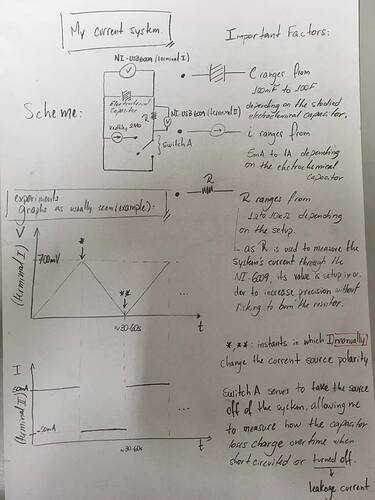Hello guys! I really appreciate all the help you all have been giving so far. So let's dive into details.
TomGeorge:
Hi,
What performance figure are you testing for?
What capacity?
What voltage rating?
Can you please tell us your electronics, programming, Arduino, hardware experience?
Tom.. 
allanhurst:
I'm with Tom on this - it isn't quite trivial - and your range of 5000:1 in current doesn't make it easier.
So could you post circuits of what you're done so far and explain in what ways it is inadequate?
An idea of the accuracy you require would be useful too.
I'm thnking about the classical dual-slope a/d convertor topology as a possible approach...
Allan
I have prepared two explanatory figures I think will give you a quite reasonable understanding about the current state of my tests and the problems I want to solve. Figures follow in the Google Drive link below:
https://drive.google.com/open?id=0BzgTiRaz6lg-T2F0ajFubDVoTFk
Stating it simply, I have one major problem:
I currently invert the current source polarity manually pressing a buton on the current source.
I'd like to automate this process using the voltage reads between the electrochemical capacitor poles as the input to determine when the polarity should be inverted. Shortly: 700mV (reverse it), 0mV (reverse it back).
Why so? Cause I want to run these experiments for several hours, maybe days to see how the capacitor performance changes over time and each cycle of Charge-Discharge actually needs to be manually switched.
Should it be 700mV exactly? Yes, cause my supercapacitor system involves electrochemical reactions that should be avoided.
As soon as I handle that, I'll try to get rid of the NI-USB6009 board to do the measurements, if deemed possible. Consider that I take voltage readings of 0.0000V precision each 10ms.
About my experience with electronics: I'm a graduate in Chemistry but have worked with the Arduino UNO in one of my undergrad modules. In this module I have learned the basics of electronics and I have developed a low cost spectrometer to monitor a reaction. It was basically a laser, an LDR as a detector and a Wi-Fi board sending the signals to an online server. I am currently doing a postgrad module in microcontroller programming.
MarkT:
There's no need for reversing current in your circuit, even though the current to the capacitor is reversed,
you just need a controlled current source to charge it and a separate controlled current sink to discharge it.
As all this is a part of a masters degree which involves analytical measurements, I need to have signal precision, accuracy and robustness. Sadly I have just one of the Keythley current/voltage sources in my lab at the moment.

